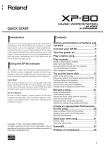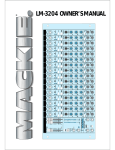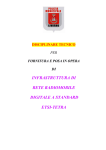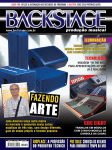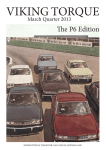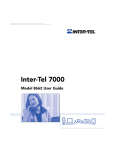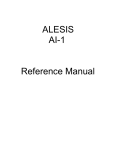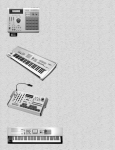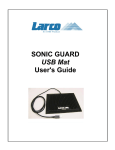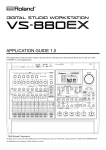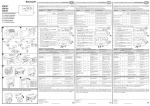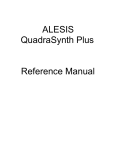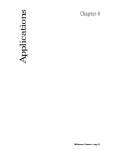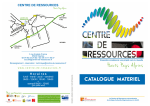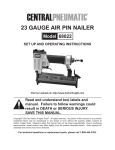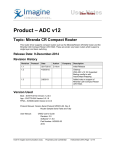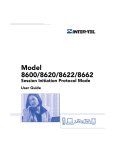Download THE NEW KORG TRINITY
Transcript
5335 Bass Road, Ft. Wayne, Indiana 46808 (219) 432-8176 THE NEW KORG TRINITY Winter 1996 INSIDE THIS ISSUE: SPECIAL NAMM SHOW REPORT More cool new stuff you can’t possibly live without was unveiled in Anaheim at this year’s Winter NAMM Extravaganza. If you weren’t there to see it for yourself, we’ve got a full report for you inside! — SEE PAGE 3 CREATE YOUR OWN COMPACT DISCS Wouldn’t it be great to be able to burn your own compact discs? Think of the convenience of storing all your computer files on one disc or putting your music on a CD. It‘s simple and we’ll tell you how. — SEE PAGE 2 THE TRIUMPHANT RETURN OF TUBES Is digital just a little too cold for you? Warm up your recordings with these new tube processors from RSP, Aphex, Drawmer, Summit and dbx. — SEE PAGE 6 SEE WHAT YOU’VE BEEN MISSING The Pro Audio Analyzer from Intelligent Devices offers four real time displays, including a Spectrum Analyzer, Phase Scope, Waveform Monitor and more. Find out why you need this metering system. — SEE PAGE 10 MACKIE’S NEW 1202 VLZ W hat does a company like Korg do to follow up on the incredible success of its best-selling M1, 01/W and i- and X-Series instruments? Simple, they just go out and design a brand new instrument that literally redefines the concept of the digital audio workstation. With the introduction of the awesome new Korg Trinity, the company has set a high standard that is sure to have the competition scrambling to catch up. So what’s the big deal about Trinity? Well, this amazing machine starts off with 24 megabytes of on-board PCM samples (which is the equivalent of 48 megs thanks to Korg’s new 2:1 data compression method) with 375 waveforms, 259 percussion sounds in 12 kits, 256 presets and 256 combinations, plus 32-note polyphony and an optional 8 megabytes of flash RAM storage (more on that later). You can even add a plug-in card that effectively adds the new Korg Prophecy Synth to Trinity, giving you total access to all the new synthesis capabilities of that instrument (see page two for more on Prophecy). Then there’s Trinity’s new touch-sensitive screen, a very cool feature that’s sure to be an immediate sensation. All you have to do is reach out and touch the large, nicely backlit display to step through sounds or edit your programs and effects. All sorts of graphical icons appear on the screen to help you change parameters, making editing not just painless, but almost fun! Want a synth sound? Easy. You just press the screen under SELECT CATEGORY, choose SYNTH and the Trinity lists all the available synth-type programs for you, making the process nearly effortless. The whole concept is pretty fantastic (and quite addictive we might add!). Of course, with an instrument of this sophistication, you get a full-featured 16-track sequencer with a whopping 60,000 note memory. And did we mention the 110 effects? There are 28 Level One effects (such as EQ and amp simulations), 52 Complex Modulator effects (chorus, doppler, etc.) plus 19 pitch shifters and delay lines. You can even chain together any combination of effects, just as long as you don’t exceed eight total effects. You even get two sets of master effects (such as reverbs, delays and chorusing) to use in addition to the other effects at the main outs, plus a separate EQ section. Of course, Trinity’s large, touch-sensitive screen makes editing effects a breeze. What’s more, all effects edits can be stored within — Continued on page 2 The 12-channel Micro Series 1202 mixer from Mackie has been a best-seller for almost five years. Now they’ve actually improved it! — SEE PAGE 6 K2500 KEYBOARDS ARE HERE! The wait is finally over! — SEE PAGE 6 PLUS Opcode’s Studio Vision Pro, Rode Mic, KRK Subwoofer, Roland Electronic Percussion, Presonus Processors, Community Speakers and much more! Sweet Notes Winter 1996 Page 2 KORG PROPHECY SOLO SYNTHESIZER The new Korg Prophecy wails like an authentic monophonic analog synth. Heck, with its 37-note keyboard, it even looks like an analog synth — one you’re meant to really cut loose on for soaring leads lines or subwoofer-challenging bass. But there’s more to this hot little synth than you might at first suspect from its outward appearance. First of all, it was designed by Korg’s engineering team to produce the most accurate analog-sounding timbres, yet with the inherent stability and flexibility of a digital machine. And since it’s a Korg product, there’s a lot more horsepower under the hood. Like seven synthesis algorithms, including physical modeling of plucked string, brass and reed instruments plus ring modulation and VPM (essentially two-op FM synthesis) capabilities along with hard-sync, pulse width modulation and comb filtering. You also get dual oscillators with four LFOs, six envelope generators(!), plus Korg’s own proprietary waveshaping, dual multimode filters and effects like distortion, auto-wah, panning, parametric EQ and chorus/re- verb. There’s even a built-in arpeggiator! Can you name any analog synth that has even a fraction of that sonic power? Oh, but you want to know what it actually sounds like. Well, that’s really the best part. It sounds fantastic! Yeah, we know, you hear the same thing about every synth or sampler that comes along, but the Prophecy is indeed in a class of its own. It’s the only true, monophonic synth designed specifically for soloing, so you get exclusive new controllers for incredibly expressive real-time control of pitch bends, modulation, brightness, volume and more. Plus, this is the only THE NEW KORG TRINITY — Continued from page one a Program or Combination, so you can edit to your heart’s content without worrying about losing the original effect. There’s also, as you might expect, a DOS-compatible, high-density disk drive onboard, plus full SCSI capabilities. An optical (for connection to your Alesis ADAT XT) as well as an S/PDIF digital interface is available, as is a 4-track hard disk recorder (did these guys think of everything, or what?) Modulation routings on the Trinity are almost limitless. A function called Alternative Modulation Source enables just about any parameter or controller to modulate another, making for some very impressive real-time sonic possibilities. You can control the level or amount of the modulation via the pitch/mod stick or from Korg’s touch-sensitive ribbon controller (a feature we particularly like). We promised to mention Trinity’s flash RAM capability and here’s where things really get interesting. First of all, like the built-in ROM sounds, the flash RAM uses 2:1 data com- pression, meaning you get the equivalent of 16 megs of RAM! This is incredible! With flash RAM installed, you can load in sounds from any Korg or Akai library, then use that data either by itself or along with internal sounds to create just about any sound you can imagine. The possibilities are endless. As you might expect, there’s a ton of stuff we just don’t have room to tell you about here. But we know you’re wondering what such a powerful machine might cost. As expected, it’s not cheap, but such innovative instruments rarely are. List price for the basic 61-note Trinity is $3599, while the Trinity Plus (with on-board Prophecy synth) retails for $3999. There will even be a Trinity Pro X with all the features of the other Trinity models plus an 88-note, fully weighted-action keyboard, digital I/O and hard disk recording for $6999. Of course, you know by now that we would never let you pay retail price for any product, so we’d suggest that you call your Sweetwater sales engineer for complete information, availability and special pricing on the Trinity of your choice. truly affordable synth to offer the latest physical modeling synthesis technology which has its own totally unique sound. Here’s a little trivia for you: You might note that the name Prophecy is a bit reminiscent of the old Sequential Circuits Prophet 5 synthesizer. Actually, back in the mid-1980s, when Sequential fell on hard times, it was purchased by Korg and many of the engineers and product designers from the original Sequential team were retained by the company which also took posession of the proprietary Sequential technology (hence came the popular Korg Wavestation which was developed from a product originally designed by Sequential, the Prophet VS). So it’s rather appropriate that this new instrument’s name is very much like that of the legendary Prophet 5, which — in a complete turnaround of technology — was actually the first commercially available polyphonic synth. All that history aside, this is an instrument that caused Keyboard magazine’s Jim Aiken to write, “If you consider the amount of synthesis power in the box, the Prophecy is a steal at $1599 list . . . if ever there was a time for a rebirth of synth lead playing, the time is now.” High praise, indeed! If you’re looking for an instrument to use for accompaniment, like for lush strings or thick analog pads, you’d best look elsewhere (like maybe at Korg’s Trinity). Nope, this is strictly a solo synth, and a truly impressive one it is! So if solo synth is your thing, now’s the time to call your Sweetwater sales engineer for more information and your special pricing on the fabulous new Korg Prophecy. YAMAHA AND MARANTZ CD RECORDERS Need massive amounts of data storage that essentially can never be lost or accidentally erased? Or how about feeling the thrill of dropping a compact disc into your CD player and hearing your own music emerge from the speakers with absolute digital purity? Then here’s a fun do-it-yourself project that will appeal to musicians and computer buffs alike: Burning your own CDs. Sound like a dream come true? Well it’s real and it’s technology that you don’t have to wait for any longer because we now stock great CD recorders from two industry giants: Marantz and Yamaha. Those of you who know how exciting this development is are probably already headed for the phones (operators are standing by . . .) while others may be scratching their heads and wondering what all the fuss is about. For the second group, we offer the following basic primer on CD technology. AUDIO CDs: These are compact discs designed to reproduce music. Up until recently, if you wanted a CD of your own recordings, you had to pay enormous sums of money for one-offs or even more to have copies pressed by a CD plant. Today, you can make your own one-offs for about $10 each if you own a Marantz CD Recorder. We have a few of the original Marantz CDR610s still in stock for under $4000. Or you can go with the latest CDR620 (which should be shipping very soon) for a list price of $5000. CD ROMs: If you want to store huge amounts of data from your Mac or PC, or if you need to make image files from computers or samplers, you’re probably going to want to get your hands on the new double speed (2X) Yamaha CDE102 at a list price of just $1450 or the quad speed (4X) CDE100 at $2145. These machines will also produce audio CD oneoffs when used in conjunction with Digidesign’s popular MasterlistCD software. Want to know more? Just give us a call and your helpful Sweetwater sales engineer will be happy to help you with information and special pricing on the CD recorder that best fits your needs. There’s a lot to tell you about this developing technology and these fine recorders — a lot more than will fit into this space. So call now. Within days you could be creating your own audio CDs or CD ROMs! Sweet Notes Winter 1996 Several of us from Sweetwater Sound attended the 1996 NAMM International Music Market which was held January 18–21, 1996 at the Anaheim Convention Center in Anaheim, California. This amazing 4-day show featured over 1,000 exhibitors and was attended by over 50,000 registered attendees who excitedly swarmed over the 410,000+ sq. feet of exhibit space! The extra added day was a blessing as there was just too much new gear and software to see in only three days. And to think we almost didn’t make it due to some nasty winter weather. Space doesn’t permit us to tell you about everything we saw, so if you want to read more about Winter NAMM, check out our World Wide Web site for an in-depth report with some exclusive photos and check out our next issue of Sweet Notes for more on these new products. AKG showed for the first time their MicroMic Series II microphones: C419 Wind Instrument Mic, C420 Headset Mic, C418 Drum and Percussion Mic, C411 Acoustic Pickup, DB1 Double Bass Bridge Pickup . . . all very cool! Alesis made price-point history with their new QS8 64Voice, 88-Key Expandable Master Synthesizer retailing at only $1,999! This roadworthy unit has 16 megs of ROM and 640 Programs expandable via two card slots. You can even load your own samples via their Sound Bridge 2.0 for Mac and PC. The keyboard action feels incredible! Also new: the ATK Integrated Drum Trigger System with DM5 Drum Module, 7 Pads, High Hat, and Kick Trigger for under $2,000! Audio-Technica showed its new 1100 Series True Diversity Wireless Microphone System comprised of the ATW-1127 UniPak transmitter system, the ATW-1128 handheld dynamic and the ATW1129 handheld condenser microphone system. Competitively priced in the $499 to $900 range. All three systems feature true-diversity reception with two independent RF sections for superior reliability and a selection of 20 VHF frequencies for minimum interference. The company has also expanded its 40-Series mics with the AT4041, a pressure-gradient capacitor mic with uniform cardioid polar pattern, designed for professional recording and critical broadcast applications. Retail price is just $395. Coda Music Technology recently reduced the suggested retail price of Finale (now $545) and Allegro ($199) music notation software. Recent upgrades have made these industry standard, award-winning applications even easier to use. Crown displayed their CM-700 Cardioid (among other great mics) for semi-pro and pro studio recording and sound reinforcement with bass rolloff/cutoff switch ($289 retail). We have them in stock now and have been selling a ton of them. Digitech showed their new VTP-1 Tube Preamp (under $1,000 list) which incorporates a vacuum tube mic preamp, tube/ line amp, flexible EQ section and a digital output plus a 18 bit A/D converter all in an attractive 2U chassis. It’s fantastic for warming vocal tracks as well as running synths, guitars and basses directly into a recording device. It looks very “retro” and knowing Digitech I’m sure it sounds incredible! The Emulator 4 Keyboard from E-mu Systems had large crowds trying to get their turn to play. It’s basically the E-IV rack (128 notes plus room for 128 MB of RAM) with a 76 note velocity and pressure sensitive keyboard plus 4 Slider Controllers, an 18bit effects board and standard MIDI sequencer. It comes equipped with a 270 MB internal hard drive loaded with more than 150 MB Page 3 of new sounds. The SoundSprint feature allows you to quickly browse through the hard drive as if it were a “virtual ROM Bank”. Very impressive! There are two versions: a 128-voice version ($4,895 list) and a 64-voice version ($3,995 list) which can be updated with an option board. Wow! JBL introduced the MR900 Series Sound Reinforcement Speakers (based on the popular SR800 Series) with even better sound quality and protection with new features including SonicGuard Circuitry, redesigned crossovers, Neutrik Connectors, HF Compression Driver, SHG cast frame woofer and more. These speakers are built for the road and are available in eight configurations. Also on JBL’s menu is the new TR Series. JBL wanted to make a more affordable speaker but without compromising quality. The TR Series has features from their high-end concert touring and live performance systems (like SonicGuard and liquid cooled compression drivers made with titanium). Available this spring starting at $549 retail. The Korg booth was packed with people waiting to see Joe Zawinul push the Prophecy and Trinity keyboards to their full potential. There was also a once-a-day preview of the long awaited OASYS keyboard which all of us can’t wait to play. On the recording end, Korg was showing their SoundLink DRS which is a collection of recording components designed to work together as a complete system. These include the 168RC Digital Recording Console (about $3,500), an affordable, fully digital, 8 bus automated recording console. It has a 16x8x2 configuration with a total of 24 input and 22 output interfaces in a combination of analog, ADAT Optical and S/PDIF formats. The new RM8 Reference Monitors were engineered and manufactured as a team effort with Boston Acoustics to create the ultimate in very low distortion and accurate sonic reproduction for under $500. These gorgeous speakers were designed to be driven by the new RMA 240 Monitor Amplifier, a 120 watt per side amp which uses a minimal component count so the sound quality is very open and detailed. Kurzweil is now shipping the K2500 76-note semi-weighted ($4,720 list) and K2500X 88-note fully-weighted keyboards ($5,250 list).They also announced their newest 61-note K2vx ($3,495) and K2Svx with Sampling ($4,195) keyboards. They both have 24 MB of ROM on board, plus PRAM and 600 Factory Programs, 300 Setups and over 80 QA Banks. There will be an upgrade for existing K2000s later this spring. Lexicon demonstrated the new PCM 90 Digital Reverberator which offers Lexicon’s highest quality reverbs in a compact, single space, affordable package ($2,995 list). The PCM- SWEETWATER SOUND • 5335 BASS ROAD, FT. WAYNE, IN 46808 FAX: 219•432•1758 [email protected] http://www.sweetwater.com 90 can create realistic reverbs from large canyons down small spaces like phone booths and drum rooms. These can be controlled in real-time by preset or custom controllers. Mackie has once again dropped the jaws of all who passed by with their new MS1202 VLZ, MS1402 VLZ,and CR1604 VLZ ($429, $599 and $1199 respectively) which all feature new circuitry that keeps these mixers as quiet as humanly possible. They also gave a sneak peek at their newSR40•8, a large-format, center-master section-style 40+4x8 mixing console with an unbelievable price-point (under $10,000). Every time I went by the Mark Of The Unicorn booth it was packed. Industry legend Don Muro was astounding the audiences with his killer demo of Digital Performer. I even saw Phil Ramone’s jaw drop! Opcode announced OMS 2.0 for the Mac and Vision 2.5 for Windows with more impressive new features than ever. Last year Clavia DMI made a big splash with the Nord Lead Virtual Analog Synthesizer. Now, with Software ROM Update 2.0, your Nord Lead can have from 10 to 30 Analog Drum Kits with as many as 8 zones each, plus 100 more Factory Performances, a new Notch Filter and many additional MIDI features. The retail price was also lowered. If you’ve already got 12 voices and want 12 more, get ready for the Nord 12-Voice Expander (price to be announced). Panasonic showed us their new SV-3800 Professional DAT Recorder ($1695 retail) which features new 20-bit resolution DACs together with the same type of 1-bit, 64 times oversampling A-D converter employed in the SV-3700. Rode has brought back a “classic” sound to recordings with the Classic Valve Mic ($1799 list). It uses the rare (and costly) 6072 tube which produces plenty of warmth and richness and it even comes with a custom flight case to keep it safe between sessions. The body is hand-crafted from solid brass, textured with fine glass bead blasting plus a nickel finish. The huge Roland booth showed a lot of new products. Their breakthrough VS-880 Digital Studio Workstation is a completely self-contained digital recorder/editor with a integral mixer, optional onboard effects and removable or fixed storage media. It stole the show with a list price of only $2,495 including an internal 540MB hard drive ($2,895 with a Jazz Drive)! On a smaller scale is the PMA-5 Personal Music Assistant ($595 list), a palmheld workstation with a 306-tone GM/GS sound source, 8-track sequencer, Intelligent Arranger and serial port, all operated with a custom LCD touch-panel. The amazing VG-8 can now go even further with the new user installable VG-8 Expansion Board ($195), which adds four new instrument models including the long awaited “hollow-body” for acoustic and electro-acoustic sounds. There are also seven new pickup models, three new amp models, and even new effects including pitch Shifting and wah-wah. Soundcraft unveiled a new professional recording console called the Ghost. It offers 4-band equalization with two fully parametric mids, 10 aux busses, a MIDI muting system, time code sync, machine transport control and 4 MIDI data faders. Prices start at just $3,950 for the 16-channel version Spirit showed off the Spirit 8 Live Console available in four frame sizes: 16, 24, 32, and 40 channels, with up to 64 inputs available on the 40-channel version. Spirit Live 8 mixes 8 buses — Continued on page 9 219•432•8176 Sweet Notes Winter 1996 Page 4 OPCODE’S STUDIO VISION PRO 3.0 by Mac McCormick, Opcode Systems It’s called the “Buzz”. Now buzz may just be a word, but as software developers, we love it when we have it, and there is a lot of buzz going on right now about Opcode System’s Studio Vision Pro 3.0. Buzz can be generated by many things, including marketing and word of mouth, but there is no buzz like the buzz that is generated by the product itself. I may be biased, (well, okay — I am biased) but I feel that the Studio Vision 3.0 buzz exists because the product has new audio features that no one else in the industry has. What’s more, these knockout features are implemented in a musical way (yes, musicians can actually use them) and to top it all off, they actually work incredibly well! In this article, I will try and explain these new features, and hopefully give you some ideas as to how you might use them in the real world. In Studio Vision’s updated DSP menu, you will see a plethora of new commands. I am going to concentrate on the five most talked-about: Pitch Shift, Time Scale, Adjust Audio Tempo, Audio to MIDI, and MIDI to Audio (yes, it says MIDI to Audio!). Pitch Shift is, in principal, a very simple concept. You want to transpose that guitar part you just recorded into a different key. The problem is that when you usually transpose audio up or down, it plays faster or slower. So, after transposing, the guitar part in question is out of sync with the rest of your recorded parts (I’ve played with some bad guitar players before, but . . .). Studio Vision compensates for this problem by expanding or compressing time at the same time it performs its transposing duties. Therefore, your file remains the same length whether you transpose up or down. Cool. Ever find a couple of audio drum loops that you thought would sound great together, only to find out they were at different tempos? Time Scale is the feature for you. Time Scale could, in a way, be considered the opposite of Pitch Shift. With this feature, you are able to expand or compress a file’s length without changing its pitch. In the Time Scale dialog box you are given the start time, end time, and duration of the selected audio event. You can view this information as measures and beats or in SMPTE time (hr, min, sec, frm) and can then change the end time or duration to stretch or compress the file to the desired length. You also have the option of setting a scale factor from .5 to 2.0 in increments of 0.001. Handy just in case you want to exactly double or halve the length of the audio but you’re not a mathematician. (Um, let’s see. Two seconds and 23 frames times two equals? Hmm...) In the example above you could change either drum loop to match the other, or you could change both loops to a different common length. I’ve seen people spend an entire afternoon in the studio doing this procedure using a sampler. In Studio Vision Pro 3.0 you could do it accurately in a matter of minutes! After making them both the same length, a neat trick is to figure out the number of measures in your drum loops (this is very easy: just listen to them and count — no computer needed), then select them, go to the DO menu and Scale Time. (This is a different command from the audio Time Scale.) There you just tell Studio Vision that your audio events are four bars (if that is what you counted), and the program will calculate the tempo of your drum parts making them fit exactly 4 bars. After that, just loop those suckers and you’re on your way! While it may not be the most widely publicized Studio Vision feature, I feel that this next item is one of the most powerful and musically useful features in any digital audio program. It’s called Adjust Audio Tempo. In short, it lets you change an audio region’s duration not by thinking of it as a static length of measures/beats or minutes/seconds, but as a dynamic ever-changing tempo. In its simplest form, this feature lets you change your song to a new tempo after you’ve recorded the audio! This is the “New Tempo” option. Is your song too fast at 120 bpm? Slow it down to 116 bpm if you want. All SV 3.0 asks for is the initial tempo, which it defaults to anyway (a nice feature). You then just type in the tempo you want and — bingo!— Studio Vision adjusts the file to fit that new tempo. But there’s another even more powerful option in this dialog box. It’s called “New Tempo Map”. Music is rarely without tempo changes, whether they be slight variances or very noticeable retards and accelerandos. This option lets you create a file from your existing audio that will follow any tempo changes you have made in your sequence. For instance, in Studio Vision’s strip chart you can “draw” a new tempo map with any number of useful tools, or in the event list editor you can numerically make any tempo changes you wish. The Adjust Audio Tempo option faithfully adjusts the audio files so that they follow any and all tempo changes you’ve made in one easy procedure. Audio To MIDI is the second most publicized feature of Studio Vision 3.0. It is unique in the fact that it does not just look at the audio file and create a bunch of MIDI notes that approximate the pitch content of the audio. It actually analyzes all aspects of the file and converts that information to MIDI notes/velocity, MIDI volume, and pitch-bend! Almost every nuance is retained to the point where you can play both the audio and the converted MIDI back simultaneously and they will track in perfect unison no matter how intricate the original audio file may be. There’s even an option that allows you to convert brightness to a MIDI controller (typically Controller #74 on most synths). This in itself is amazing as you can now double any single audio line with a MIDI instrument or convert your audio to music notation. But if you notice in the DSP menu, there is also a MIDI To Audio command. What? How could I convert MIDI information to an audio file and why would I want to? Well, imagine you have, say, a vocal line you’ve recorded into Studio Vision. Imagine converting that to MIDI. Now that it’s MIDI, you have individual editing control over many musical parameters. I mean, MIDI is real easy to edit, right? So just fix the pitch of a flat note by re-drawing some of the pitch bend information, change another note just by dragging that MIDI note event to a different pitch in the graphic editing window. (That’s the note you really wanted to sing anyhow, but you couldn’t quite reach it!). Also, you wanted to crescendo that long note you held at the end, so you just draw in some MIDI volume information. And now — you guessed it! — you can take that new edited MIDI information and convert it back to digital audio with all your edits intact! What we have done is, in a way, given you the ability to break your audio performance out into many of its component parts, and allow you to individually edit those parts in a very easy and graphical manner. You can then convert that information back to affect the original performance. In essence, MIDI becomes a tool for editing digital audio. When I first heard about it, I didn’t believe it either. Combine all this with TDM implementation, completely new faders, support for all of Digidesign’s hard- ware (including Pro Tools 3), and an award winning MIDI sequencer, and you have one of the most powerful music tools ever created. Oh, and just in case you’re wondering what other people think about Studio Vision 3.0: • Mix magazine TEC award (1995) • Electronic Musician “Editor’s Choice” (1995) • Keyboard magazine 20th Anniversary Readers Poll Winner (1995) • MacUser magazine Editors Choice Award, “Eddy” (1995) • AES Show Pic 1995 (EQ magazine) • New Media magazine “Editors Choice” Hyper Award (1996) Buzz, buzz, buzz . . . Visit the Opcode Web site at “http://www.opcode.com”. Sweet Notes Winter 1996 A BRAND NEW YEAR By Chuck and Brenda Surack Owners, Sweetwater Sound It’s hard to believe it’s 1996 already. Seems like we just got used to writing “1995” on our checks. Maybe that’s because so much has been happening here at Sweetwater over the last 365 days. Actually, we hope all our customers have enjoyed the many new products and services we’ve introduced during this past year. And of course, none has been more exciting or better received than our World Wide Web site! So far, more than 25,000 people have checked out our home page — maybe you were among them. We hope so, because it’s really a labor of love for everyone involved with this project. We believe it’s the way most people will get their information in the future, so we’ve put a lot of effort into making it a fun place to visit, as well as being timely and informative. We’ve even recently redesigned the home page (see photo) to make it easier to access the information you’re looking for, whether it’s back issues of Sweet Notes, catalogs on-line, late-breaking news or any of the other areas available at our Web site. There will always be something of interest for all our customers here, and as the Internet grows (and it’s going to continue to grow at a phenomenal pace), so too will our Web site. Just access “http://www.sweetwater.com” via any Internet service provider and take a look at all the information available right on your computer screen just by hitting a few keys. During the last few months of the year, we added free Internet mailing lists like our brand new Trading Post (“[email protected]”), a great place to sell equipment you’re no longer using, or to find certain gear you might be searching for. There’s also EFlash for new product announcements (“[email protected]”) and MusicalNotes (“[email protected]”) where subscribers can discuss any topic relating to MIDI and recording technology. Certainly 1995 will always be remembered as the year when Sweet Notes went full color, much to the delight of our Page 5 thousands of customers. And we enjoy nothing more than delighting our customers, particularly since without them we’d be just another music store. And during the last year we introduced our exclusive Line of Credit account (see bottom of page)and expanded our leasing programs, making it easier than ever before to get the equipment you want and need. In 1995 we were honored to be the first choice for audio equipment for the soundware departments of a number of major manufacturers and developers including E-mu Systems, Young Chang R&D, SEGA, Sierra On-Line, Origin Systems and Boss Game, just to name a few. We also helped Science Central Museum design and install a one-of-a-kind laser triggering system on their main stairway which was used to trigger several Alesis D4 percussion modules and Roland MS1 samplers which would play various sounds as people walked up and down the stairs. Finally, we might also mention that thanks to the support of our thousands of loyal customers, we experienced our biggest year ever in 1995, meaning that Sweetwater Sound is once again the fastest growing music technology retailer in the country (that’s the third year in a row). There’s no way we can possibly express our thanks except by saying there will be plenty of surprises ahead. We will be adding many new products from some of the very best (and most prestigious) manufacturers in the music business, giving everyone more choices of exceptional products in more price ranges than ever before. We will never stop trying to develop exciting new services that will help all our customers gain access to valuable information and, more importantly, make it easier and more fun to make music. And before we forget (as we’re running out of room), special thanks to Roger Nichols, the man behind the console for all of Steely Dan’s incredible recordings, for presenting a wonderful seminar to our midwest customers last fall and for mentioning in his December EQ magazine column that one of the things he wanted for Christmas was “a one-hour shopping spree at Sweetwater Sound in Ft. Wayne, Indiana.” Oh, and check out Roger’s Recording Guide on our Web Site, too. Thanks, Roger and thank you all for a wonderful 1995. The best is yet to come in 1996 and beyond! YOU MAY BE PRE-APPROVED FOR A $10,000 LINE OF CREDIT! Sweetwater Sound has just introduced the music industry’s first Line of Credit Account. Need a new digital multitrack? Or how about that killer microphone you’ve always wanted for your studio? A new Godin MIDI Guitar? A set of state-of-the-art, bi-amplified studio monitors? A K2500? Pick from thousands of items. To find out if you are already approved, just pick up the phone and call your Sweetwater sales engineer at 219•432•8176. We can give you a quote on whatever equipment you need or want with absolutely no obligation. ACT NOW AND WITHIN DAYS YOU CAN BE MAKING MUSIC WITH BRAND NEW EQUIPMENT THANKS TO THIS EXCLUSIVE NEW PLAN! Q: In my studio, I want to put one type of reverb on my drums and another multi-effect setting with reverb, chorus, and delay on vocals. My QuadraVerb 2 is a multi-effects unit, so shouldn’t I be able to do this? A: Yes. Many multi-effects units, while being able to have several effects active at once, cannot process independent signals because their internal routing isn’t flexible enough. Fortunately, with the Q2 you can do this. A whole clinic on all of the programing options in the Q2 is beyond the scope of this forum, but here are some basic ideas that will help. The Q2 does have very flexible routing schemes. The effects modules (up to eight) can be set up in any order and just about any output can be routed to any input anywhere in the device. So here’s basically what you do: Start with a blank patch or clear a patch completely. Figure out exactly what effects you want to have and create those modules in the Q2. You have two inputs available (L & R), so you need to make a decision as to which one will be used for the drum reverb and which will be used for the vocal multi-effect. For now, lets say the left input of the Q2 is for the drum reverb and right is for the multi-effect. Next you need to create a routing that sends the left input of the Q2 to the reverb module you created. The reverb has a stereo output so just go ahead and route its left output to the left out on the Q2 and the right to the right output on the Q2. So now you can send a signal from one of the aux outs on your mixer to the left input of the Q2 and get a stereo reverb at its output. Next create a routing from the right input on the Q2 to the first effect in the multi-effect chain you want to create. Then go ahead and do all of your routings in the multi-effect chain you are building and take its final out (the output of the last effect in the chain) to the left and right outputs in the Q2 just like you did with the reverb patch. Now you can set up a second aux send on your mixer to feed this right input of the Q2 and a stereo multi-effect will be present at the Q2’s left and right outputs. So one aux on your mixer feeds the left input and generates a stereo reverb and a second aux feeds the right input and generates the multi-effect patch you created in the unit. Both the reverb effect and the multi-effect will be present together at the left and right outputs of the Q2 where they get returned to your mixer. So if both of these effects are returning to the same pair of channels in the mixer how do you independently control the relative levels of these two effects? Every routing you make in the Q2 has a programmable level associated with it so you can pretty easily set up the relative levels right in the Q2. If you need real time access to these, just set it up so that they can be controlled with a MIDI controller (its easy to do this — check your user’s manual). You can also make changes by how much signal you feed to each of the inputs. In other words, if the reverb is too loud compared to the multi-effect patch, simply turn down the left input so not as much signal gets to the reverb. Too extreme a setting will compromise your signal-to- noise ratio, but for fine adjustments this is the easiest way to accomplish it. There are many, many more things you can do with the QuadraVerb 2, so hopefully this will serve as a starting point for continued experimentation. Got a question? Well, we’ve got answers! Simply mail your question to Sweetwater at 5335 Bass Rd., Ft. Wayne, IN 46808 or send e-mail to “[email protected].” Sweet Notes ELECTRONIC PERCUSSION Drum roll please . . . Say, that sounds pretty good. In fact, it sounds so totally realistic you’d swear that roll was being played on real drums! Actually, it’s being performed on Roland’s new Compact Electronic Drum System, everything you need in a professional-sounding digital percussion setup in a highly portable integrated system. Actually, there are now two complete systems available to those of you who know how to keep a beat: the Roland TDB-7K (pictured below) and the latest addition to the Roland electronic percussion line, the TD-5K. The TDB-7K delivers an immense selection of true, CD quality digital samples — 512 of them to be precise including 114 snares, 89 kicks plus 88 percussion sounds (like toms and cymbals) as well as many special effects, melodic percussion and bass sounds. The System comes with 32 preset patches that include rock, jazz, brush, latin, orchestral and even classic TR-909 and 808 kits, among others, so you’ll never run out of sounds. No matter what kind of music you play or how you play it, the Compact Drum System will respond to every movement of your hands, sticks and feet, all without you having to adapt to new techniques. Whether it’s ghost notes or raw, full-power snare hits, cymbal chokes or rim shots, the TDB-7K’s response is flawless. What’s more, its sensitive response with natural tonal changes and dynamics are unlike any percussion instrument you’ve ever played. List price for a complete TD-7BK System starts at $2050. The TD-5K Compact Drum System offers the same superb sound quality and expressiveness as the TD-7BK, but it incorporates a new sound module, new pads and a new kick trigger along with the remarkably affordable retail price of just $1795. Of course the TD-5K delivers outstanding 16-bit digitally processed sounds (including 210 instruments in 32 patches) as well as built-in digital reverb for finishing off your drum sound. Considering how sophisticated both of these systems are, we don’t have nearly enough space to tell you about all their many features (not to mention all the options). So give your Sweetwater sales engineer a call today. They can tell you a lot more about the Roland electronic percussion systems, as well as providing you with your special low Sweetwater pricing on the set that best meets your needs! Winter 1996 Everyone knows that Mackie’s MS1202 Mixer is probably the best selling portable 12-channel audio mixer in history. With performance that rivalled units costing many times as much, there was a good reason for its success. Now, almost five years later, Mackie Designs has unveiled the next generation MS1202VLZ Mixer. At $429 retail, does it live up to or even exceed the performance of the original? Let’s take a closer look. The new 1202VLZ uses a new Very Low Impedence circuit design that Mackie initially developed for their 8-Bus consoles. This circuit reduces thermal noise and seriously cuts down on crosstalk. This new board is also built like a tank, just like the original, making it rugged and dependable in even the most demanding applications. Of course there are four mono mic/line channels with true studiograde mic preamps and 48V phantom power plus four stereo line channels. The 1202VLZ also features two aux sends per channel and two stereo aux returns plus an Aux 1 master level and pre/post switch. But what is probably going to interest many of you is the fact that this new mixer now has a full 3-band EQ (just like the Mackie CR1604 and LM3204) with integral Low Cut filter centered at 75 Hz, which is great for cleaning up muddiness in recordings or live sound work. There are now balanced XLR outputs, along with Page 6 MACKIE DESIGNS MS1202VLZ the original balanced 1/4" TRS output jacks, as well as an RCA tape loop interface. As on the 1604, pressing the Mute switch on every channel unassigns it from the main L/R bus and reassigns it to the Alt 3-4 outs allowing you to create two stereo pairs, bounce multiple tracks onto two more tracks, or preview a source not yet in the main mix. Space (as usual) prevents us from telling you more about the 1202VLZ, but your Sweetwater sales engineer has all the info you need plus your special pricing, so call today! K2500 KEYBOARDS NOW SHIPPING The incredible new K2500 Series is Kurzweil’s most powerful sampling synthesizer to date. Up until now, however, it’s only been available in a rackmount version. But for those of you who have been eagerly awaiting the arrival of the 76note semi-weighted and 88-note fully weighted versions, the wait is over. These units are shipping in limited numbers even as you read this. The K2500 features a brand new soundset of 200 programs and 100 setups accessing 8 megs of Kurzweil’s most spectacular sounds (it also ships with a disk containing more than 1,000 additional programs). By adding the optional soundblocks — Orchestral and Contemporary ROM plus a brand new stereo Grand Piano — the K2500 expands to 28 megabytes of internal ROM samples. Both the keyboard and rackmount versions offer 48 note polyphony, up to 1.25 megs of program memory and up to an unbelievable 128 megs of sample RAM via easyto-find SIMMs (which Sweetwater stocks, of course). Of course you get features like a 32-track sequencer with full event editing, comprehensive digital and analog interfacing, two ribbon controllers and eight sliders, all of which are fully assignable. You also get an operating system that’s totally user upgradable. And all at a list price of $4720 for the 76-note version or $5250 for the 88-note K2500x. But that’s not the only news from Kurzweil. The company has also released their latest version of the incredible K2000 Series. It’s dubbed the K2vx and it’s basically a K2000 with all the bells and whistles installed, like expanded PRAM and both optional ROM blocks. It carries a suggested list price of $3495 and it should be shipping right about now. Own a K2000? Great, then you still have a killer machine that can be upgraded with both ROM blocks, the sampling option and sample RAM up to 64 megs, PRAM and more, all of which we have in stock right now. In fact, we even have new software (developed exclusively for K2000 owners by our Soundware Development Facility) that will essentially make your K2000 sound very much like a new K2500 (with new programs and effects) for only $189. We also have the most extensive collection of samples anywhere for both the K2500 and the K2000, including our own five disc CD ROM library (with more on the way). So call your Sweetwater sales engineer today for more information and pricing on the K2500 or K2000 of your choice, as well as all the many options and accessories we stock. Sweet Notes Winter 1996 Page 7 TUBE GEAR IS HOT! In case you haven’t noticed, vacuum tubes are making a comeback, and in a big way! Seems that while many people love the clarity and accuracy of digital audio — who wouldn’t? — they miss the warmth (no pun intended . . . really) and overall “beefiness” of analog. And what could possibly be more analog than tubes? So, some engineers started experimenting with the concept of using one tube-driven device within the digital audio chain to restore the richness typically associated with analog. And it worked! The Saturator from RSP Technologies is a 2U rackmount device that exists only to add warmth to digital tracks thanks to its two 12AX7 tubes. Insert it between the recording console’s stereo bus and a DAT machine (or hard disk or CD recorder) and — voila! — instant analog! The unit can also be routed through a mixer’s insert points to process individual tracks. Controls are minimal: just Drive and Output, but combined with the unit’s proprietary circuitry, they can actually create the classic saturation curves of hot signal-level analog recordings, yet your final product will retain all the sonic benefits of digital technology. List price for the Saturator is $699. From dbx comes the 1650T Compressor Limiter, a world-class microphone preamp (with a dynamic range of 154 dB, which is actually beyond the range of human hearing) combined with dbx’s legendary dynamics processing. The unit RODE NT-2 Seems like the selection of affordable, ultra high quality microphones is growing every day. Case in point: the Rode NT-2 from Australian-based Freeman Electronics. Carrying a retail price tag of just $749, the NT-2 comes standard with features usually found on much pricier mics, like a large capsule with gold-plated membrane, dual polar patterns, high pass filter, -10 dB pad, low noise transformerless circuitry, gold plated output connector and internal head pins and exceptional frequency response. Plus, it even looks cool! For more on this great-sounding mic, call your Sweetwater sales engineer today! was designed by the legendary New York studio installer Greg Hanks. It is a very cool, retro-looking piece which includes emulations of many of the most popular compressors. i.e SSL, Neve, etc. It includes 48V phantom power and fully balanced ins and outs at a list price of $2999.95, which is very reasonable given the sophistication of this unit. The company’s patent pending methods of tube control give the 1650T exceptional performance that has, until now, been unattainable using conventional technology, yet at the same time provides the pleasant “tube sound” everyone seems to be looking for without unnecessary audio tradeoffs. We’ve actually mentioned the Aphex Dual Channel Thermionic Mic Preamp Model 107 in a previous issue of Sweet Notes (you do save your back issues, don’t you?) and at the time we praised the unit for its sound, as well as its affordability (just $595 retail). Boasting a revolutionary new tube circuit called Tubessence, the Model 107 delivers the sonic characteristics of tubes without the extremely high voltages, heat, fragility and short life span of traditional tube circuitry. And now there’s also the Aphex 661 Expressor which combines the company’s Tubessence mic preamp circuit with its Easyrider compressor/limiter in a single channel tube processor that offers unparalleled audio performance and flexibility at the surprisingly low list price of just $749. You get three compression curves (hard knee, soft knee and “no-knee”) plus automatic (Easyrider) or manual (Expressor) operation, each selectable from the single rackspace unit’s front panel. From Summit Audio comes the Model DCL-200 Dual Compressor/Limiter. Based on a proprietary hybrid design, the DCL-200 is a two channel compressor/limiter that combines selected 12AX7 vacuum tubes with highly reliable 990 op-amps in a transformerless signal path to give you the unmistakable warmth of tubes, plus the dependability of a solid state device. Features include continuously variable attack and release times, adjustable A.C. threshold, variable slope, dual meters with peak overload indicators, stereo link switch plus balanced or unbalanced outputs. Suggested retail price for the DCL-200 is $2950. Finally, from Britain comes the sophisticated Drawmer 1960 Mic Preamp/Vacuum Tube Compressor, a dual channel processor which harnesses the “life and warmth” of eight (count 'em) active tube stages. Two ultra low noise tube mic preamps with switchable 48V phan- tom power capture every subtlety your mic can deliver. The dual channel vacuum tube “soft knee” compressors offer variable Threshold control plus switchable attack and release times. Other controls include bass and treble EQ, switchable HF and Gain boost. The aux preamp section can be routed to one or both compressors to provide two channels of output for creating stereo effects from mono sources. The 1960 can even be slightly overdriven to produce the classic oversatu- rated tube sound so popular with percussion, as well as electric guitars, basses and electric pianos. Retail price for the Drawmer 1960 is $2699. As you can see, there are many options already available for adding back the popular tube sound to digital recordings and there will probably be more available by the time you read this. Which one is right for you? Good question, and one which your Sweetwater sales engineer is eminently qualified to answer. So give us a call today for more information and your special pricing on the hottest (literally) new gear on the market! C A K E W A L K Pro Audio for Windows Want to record vocals, guitar leads, horns or any other audio track right along with your MIDI sequences? With Cakewalk’s new Pro Audio Software ($249 retail) and Windows you get the power and flexibility of an award-winning MIDI sequencer along with true, multitrack digital audio recording. It’s a new standard for music software for PCs running on the Windows operating system. Use Cakewalk’s new audio tools to edit your waveforms right on your computer screen. Perform graphic and parametric EQ, crossfades, mixdowns, time extractions and other editing functions on multiple tracks simultaneously. You can even use audio tracks to Groove Quantize other tracks. Cakewalk’s new Turbo Mixer technology maximizes the number of recordable tracks available with your sound card and supports variable audio sampling rates from 11 to 44.1 kHz (CD quality). Of course, with Cakewalk Pro Audio you also get all the standard MIDI sequencing functions you could ever want like: high quality notation; realtime, step, overwrite, sound-on-sound, loop and auto-punch record modes; powerful editing like cut/copy/paste, drag/drop, pitch transpose and more. Listing all the features of this great new software package would take far more space than we have available, so call your Sweetwater sales engineer for complete information and your special pricing today! Sweet Notes Winter 1996 Page 8 HOW IT WORKS have to. Articles like this one show you what is available to you as a working musician, and we inform you of the intricacies during your consultation calls. The sequencing software enables TJ to play his primary piano part into the computer’s memory, then record new tracks over it such as drums, bass, percussion, strings, or whatever other sound on the Quadrasynth he wants to use. These are stored not as sounds, but as MIDI commands. In BY TJ SCHLENKER other words, the computer remembers what keys are struck, Sweetwater Sales Engineer how hard they are struck, what sound was used, etc. and then later these musical lines are reproduced by the computer telling the Quadrasynth or other MIDI keyboard, “Okay, Germany, 1988: Deep in the Schwäbisch hush of the what country you’re in, the song remains the same (nod to I want you to play these notes, this fast, this hard, using this sound” and so on. Black Forest, in a little two-road village nestled among green, Britain). Using a modicum of today’s technology you can In this way, TJ produces a fully arranged background for ancient hills, sixty kilometers southwest of Stuttgart. On a do extensive pre-production on any song before you go into chill night in late December, from a large, modern building the studio. Recording the rhythm section, perfecting the him to sing against next week. What’s more, he can actually print out the various parts in standard music notation or, if he now dark in the winter shadows comes the sound of a pi- groove, arranging the parts — all this can be done ahead of decides he wants to change any keyboard patch, note duration, ano, and the struggle for perfection in a writer’s hands . . . time, and you can walk away with a completed production in fact anything having to do with any of the parts, he can go in No, it’s not a John LeCarré novel, or even the story of without pawning a guitar, or even using one! how “Silent Night” was written. This issue, Sweetwater gives The method? MIDI coupled with the power and memory and edit that “MIDI event” and in a matter of seconds it’s changed. Try doing that with a taped recording! you a real-world glimpse into the ways modern music tech- of a computer. So let’s see how I (and now you) could have The Audiomedia II card is present in case you actually nology can transport you into “other lands” of swift, effec- gotten all I wanted from those three studio hours and been tive and progressive music recording and, ultimately, how more effective with time and money. The story, if it were to want to record sounds live onto your computer’s hard disk. a serious musician like yourself can save serious cash by happen today, would instead go something like this: Hav- This comes in handy when you want to record real acoustic instruments over your sequenced arrangemaking a relatively small investment. We look ments; things like bass, acoustic guitar, backspecifically today at the merits of MIDI and the ground harmonies and, of course, the all-imbenefits of linking it with the ubiquitous oneMACINTOSH Digidesign AudioMedia II Card portant lead vocal. Four tracks of real-time eyed servant so many of us have hired on: the with Sequencer high-quality digital audio are offered with this personal computer. Software card, which provides two RCA inputs to get Our story (which, as luck would have it, is the sound in. my own) begins this way: I remained a guest Because of this, TJ uses his mixing conin Altensteig for three months, primarily worksole to accept the signal from his high qualing on new material and waiting for colleagues Mixing ity studio microphone (which uses an XLR in Switzerland to secure my work visa so I Console cable and needs phantom power) and then could return and head up a local theater and runs that signal from its 1/4” output to the music group. In the interim, I met Andreus, a RCA input of the Audiomedia card. With this German engineer who single-handedly ran the MIDI connection, he puts down all his vocals, a recording studio there, and who also enjoyed Interface saxophone solo by his Berklee grad buddy, my music enough to want to record it. Res, and a oompah tuba part to make everyOn the night in question, I was practicing one really wonder! a new song called “Along The Way,” kind of Synth an Al Jarreau meets Elton John vibe. It was The Jaz drive is very cool and helpful for near midnight, and after a week I was still havthis German recording date. Because he did ing trouble playing it. The chords were mostly everything on his computer, TJ can save all jazz tonal clusters that I’d never used before, that information on his Jaz drive and on the Audio Cable and though they fit my melody wonderfully, my day of the session, if Andreus has the same MIDI Cable hands fumbled over the voicings as if they’d or similar computer set-up (most studios do) Mac serial cable just tried “The Lamb Lies Down On Broadway” he can take just one disk with him as his for the first time! “backing band” for the day. With the studio The next morning at ten, I reported to the computer doubling his own, all he has to do studio to lay the tune down, my vocal going through a ing scheduled with Andreus a three-hour slot one week from is overdub his vocal through the studio’s incredible Neumann U87 and the piano part performed on a beautiful that mild winter Monday, TJ goes off to work out the basic Neumann mic (that will be TJ’s first purchase when his alblack Bösendorfer (talk about Fahrvergnügen; I could drive piano part on his MIDI keyboard. He uses a popular synth bum hits gold status!). No hauling instruments, no crackthat piano all night!). I only had until 1:30 that afternoon with an excellent on-board piano sound, since it gives him ing under the pressure of snowballing dollar signs and clock when another session started, and I definitely felt under the loads of other usable sounds plus 64 note polyphony and revolutions, just singing the lead over tracks he created. gun. Despite the time restraints and doing everything live, I 76 keys, all of which are important to him. Thus ends the session and TJ walks home a happy comput the song down satisfactorily in two takes and got away He has the synth sitting right next to his Macintosh com- poser — just like you can! with a cassette and just enough time to get Andreus’ lunch puter, which is loaded up with sequencing and hard-disk There are many pluses to combining the powers of MIDI while he set up the next session. recording software, Digidesign’s Audiomedia II hard- and computers, some of which we’ve seen here. Other posThat was the last we ever touched that song. Time went ware card and (of course) a MIDI interface. As a bonus, he sibilities are using your computer as a digital signal proon, we both got busy. Other songs were recorded in much also uses an Iomega external Jaz Drive that gives him a cessor, as an editor/librarian for your synth(s), or as a means the same way, with a minimum of instrumentation and with full gigabyte of memory per storage disc. of bringing automation to your mixer. The bottom line on a wish, always a wish, that we could have done more. Now, Why these items? Well, recognize that the brand names these possibilities? You save time and you save money! Your until I decide to go ahead and re-record it on my own stu- aren’t the important thing. There are lots of companies with Sweetwater rep is well aware of how to help you save both, dio equipment, whenever it’s played I think of the strings lots of products. What really matters is your particular apand is only a phone call away. So do yourself a favor: stop that should have gone here, and the brush drum grooves plication and getting what is appropriate to it. This is where being disappointed with what you can’t do at a session and that should have been there. Sound familiar? consulting your Sweetwater rep is so beneficial; we do the let us walk you through what you can do. Who knows, maybe Okay, so let’s build a better mousetrap. It doesn’t matter work of studying the various pieces of gear so you don’t I’ll see you on the Autobahn one day soon. LESSON TWO: ¨ MUSICAL FAHRVERGNUGEN CRUISING THE MIDI AND COMPUTER AUTOBAHN Sweet Notes Winter 1996 Page 9 A PERSONAL LOOK AT ROLAND’S VG-8 SOUNDWARE Wouldn’t it be cool if, for your next recording session, you could line up a selection of the world’s best-sounding guitars? Like a 1959 Les Paul, a ‘57 Strat, maybe a ‘62 Tele and a ‘67 12-String Rickenbacker. Of course, if you had access to all those classic axes, you’d want some very cool amps to plug into. Like maybe a tweed ‘59 Fender Bassman, a full Marshall stack and one of those versatile Mesa/Boogie amps Carlos Santana plays through. As long as you’re wishing, you might as well add a selection of cabinets, from a single 12- inch speaker up to a full 4x12 stack and a wide range of exceptional mics to capture the killer tones you’ll be producing by this time. Oh, you say you can’t afford all that great-sounding gear? That you’d have to spend about a year’s salary on just one of those vintage guitars and a single amp? Well, that may have been true a year ago, but that was before Roland introduced their VG-8 VGuitar System. Now for about the cost of just one really great guitar you can have access to the sound of dozens, as well as countless amps to match, and all without having to lift a single speaker cabinet or spending the hours it usually takes to set up a mic to capture a killer tone to tape or hard disk! Okay, if you’re a guitar player, you probably figure this is all a lot of hype, right? No electronic gizmo could possibly give you the sound you’re after! I mean, people are willing to spend like $10,000 bucks on a vintage Les Paul. So let’s take a moment here to separate fact from fiction. True, there’s nothing like owning a spectacular guitar — whether it’s a brand new flame-top Paul Reed Smith or a '60s western orange Gretsch Nashville. After all, these things don’t grow on trees. But we’re talking about tone here, and it’s 1996, not 1966 (and realistically, who wants NAMM REPORT — Continued from page 3 affordably with suggested retail prices starting at $4299 for the 16-channel version. TASCAM introduces the 424 MKII Portastudio for the musician looking to take the next step up in multitrack recording. Superior audio quality, balanced XLR inputs, enhanced equalization and big-studio style AUX section make this the ultimate compact 4-track Portastudio. It has to be the best Portastudio ever made, particularly at $599. A new Power Amplifier, the PA150 rated at 150W sounds great and delivers the power you need at a list price of $400. Tascam also showed two new products, the DA38 8 Track Recorder, designed specifically for musicians and a MiniDisk based 564 4-Track Portastudio, due late summer. Watch for more details later! T.C. Electronic introduced their new Wizard M2000 digital studio signal processor. With the heritage of the incredibly popular M5000 behind it, the M2000 is bound to be a big hit. It has super quality effects, a brilliant user interface and includes their new C.O.R.E. (Co-efficient Optimized Room Emulator) Reverb plus seamless Morphing during preset changes and dynamic real-time control. It’s generous 250 factory presets, 250 user presets, and Dithered Digital I/O connectors are even more astounding at it’s retail cost of under $2000! — C.S. to take such a valuable instrument to gigs anyway? Not me!). So the product designers and engineers at Roland took a long, hard look at what makes for a really incredible guitar sound, took that sound apart piece-by-piece, and using the very latest physical, electronic and magnetic modeling technology, came up with a way to accurately reproduce the sound of just about any guitar/amp/ speaker/mic combination. No, it’s not magic, just the culmination of years of intensive research and development on Roland’s part. And take it from me, the proud new owner of a VG-8, it really and truly works! By adding a GK-2A pickup to any guitar you want — mine happens to sit on a pretty nice (though remarkably inexpensive) Peavey Tele copy — you can dial up any guitar sound you’ve ever heard (including basses and 12-strings) from the built-in presets or create your own using the EDIT mode. One of the coolest things about this thing is that you can find an inexpensive new or used guitar that plays well, add a GK-2A and you’re in business. Thanks to the VG-8, your tone will always be killer. Still not a believer? Well, up until two months ago, neither was I. But here’s a suggestion: if you haven’t already gotten your hands on a copy of Roland’s exceptionally well-produced audio CD which effectively demos the VG-8’s sound, I’d suggest you call your Sweetwater sales engineer immediately. It will make a convert out of you. My guess is that Roland will unveil an upgrade for the VG-8 at the Winter NAMM Show (Editor’s note: they did), but for those of you lucky enough to have one of these killer boxes already, here’s a patch I created that I believe really nails the sound of a Les Paul through an overdriven Soldano tube amp. First off, select the LP (for Les Paul) configuration from the PICKUP mode under the INSTRUMENT Menu. For now, let’s use the FRONT (neck) pickup, though you can edit this later to access the REAR (bridge) or BOTH pickups. Set TONE to a value of -5 and LEVEL to 100. PITCH SHIFT should be normal. AMP should be set to “Classic Stack” with OUTPUT set to 50, VOLUME at 55, IN-BALANCE at 41 and MASTER at 100. On Page two of the AMP menu, set PRESENCE to 20, BASS to 70, MIDDLE to 93 and TREBLE at 50. Under MIC and SPEAKER, set the SPEAKER TYPE to “1x12,” MIC on “large dynamic” and POSITION to “off cabinet.” In the EQ page, set the Mid-freq to 1007 and Mid-Q at 1.0; Lo-Gain should be at 2.5, Mid-gain at 2.0 and Hi-gain at 2.5. On Page two of the EQ menu, set Low freq to 125, Hi-freq at 7999 and Hi-type at peak. Your P-MASTER (final volume) should be adjusted to taste, as should your effects. You should now have a very accurate overdriven Les Paul tone. Play and enjoy! If enough of you VG-8 users like this patch, call or send an e-mail to your Sweetwater sales engineer and I’ll try to include a few more next issue, or maybe we’ll post some on our Web site. For those of you who don’t own a VG-8, call for Sweetwater’s special pricing and/or a copy of the demo CD. You’ll wonder why you waited so long. — David Trevor SCENE By Michael Rief, Soundware Engineer Things are moving at the speed of light here at the Soundware Development Facility. In fact, the whole department is so busy that we couldn’t spare our fearless leader, Daniel Fisher, for even a few minutes, let alone long enough to write this column. So I’m pleased to be the one that gets to fill you in on all the latest soundware projects happening here at Sweetwater — except for a few that are top secret, of course. First off, the five Sweetwater Series II CD ROMs for the K2000/K2500 have been shipping in record numbers. As the newest member of the staff, I only recently had the opportunity myself to spend an evening going through all the new programs the department has written for the existing Stratus, RSI and Grand Piano discs (which I owned myself), and I can tell you from first hand experience that there’s a lot of great programming here. I know the K2000 pretty well, but even I was amazed by some of this material — it really takes V.A.S.T. to another level and I'm sure other soundware companies are scrambling to copy many of these even as I write this column. What’s also great is that the new Series II programs perfectly complement the original programs that shipped on Series I discs. It’s almost like getting a bonus disc of new material absolutely free. If you’ve been thinking about adding one or more of these discs to your K2000/K2500 (or new K2vx) library, but didn’t know what all the excitement was about, you’ll appreciate the fact that Daniel Fisher has been knocking himself out putting together an audio demo CD of all the sounds on these discs. That‘s right: Over 300 individual audio examples of the superb samples and superior programming that thousands of satisfied Kurzweil owners have been talking about, all on one 72-minute audio CD. Now there’s no second-guessing; you can hear with your own ears exactly why Electronic Musician magazine called many of these files “. . . the best samples money can buy!” Call your Sweetwater sales engineer immediately for your copy of this super CD. It’s absolutely free (except for the usual $4.95 shipping and handling costs which are refundable if you purchase any of the CD ROMs), so what are you waiting for? It’s also my pleasure to tell you about our latest project due out this spring: “Ultimate Guitars!” I guess the name says it all: It’s tons of guitar samples from some of the best guitars on the planet courtesy of Stratus Sounds. Whether you need guitar samples for rock, jazz, blues or country, this is the disc to own, kids! What’s more, many of the instruments included in this collection have important historical significance (like the beautiful instrument shown above). Of course you got your Strats, Martins and Les Pauls, but there are also cool tones from axes like the Gretsch Nashville, Santana’s Yamaha SG2000, a PRS Custom plus plenty of basses, jazz and classical guitars, too (like the Godin Multiac). The soundware department is in the process of creating absolutely killer new programs for these great samples now, so check with your Sweetwater sales engineer for pricing and availability. Sweet Notes INTELLIGENT DEVICES AD-1 PRO AUDIO ANALYZER A properly balanced digital master or CD uses every last bit of digital range, and every song on it should come within 1/10th dB of digital clipping at its hottest point. Clearly, with such close tolerances, even the most experienced engineer needs ultra-precise metering to help match and balance songs to today’s CD standards. The new AD-1 Pro Audio Analyzer from Intelligent Devices was designed specifically to provide engineers with this critical information to help produce the highest quality professional digital masters. The AD-1 operates as a TDM plug-in, as a stand-alone application on Digidesign AudioMedia or Pro Tools hardware and with no extra hardware on Power Macs! It’s truly the ultimate real time audio monitoring tool, providing precise simultaneous stereo peak and average metering, clip indication (incredibly valuable!), headroom, margin indication, L/R sum and difference levels, spectral analysis, phase metering and, last but not least (whew!) waveform history display. The AD-1 actually replaces many thousands of dollars worth of hardware while providing simplicity, accuracy and functionality that‘s unavailable at any cost. It virtually assures you of a perfect final digital master or CD. Winter 1996 Page 10 Wouldn’t it be great if someone invented a single space rackmount processor that offered eight compressors, eight gates, eight automated fader channels, eight limiters, and eight mutes, all under digital control? That would be pretty cool, wouldn’t it? Oh, and as long as we’re wishing, we might as well make this ultimate dynamics processor affordable, too. Would it surprise you to find out that such a processor already exists? And that it is actually under $125 per channel (list price, of course)? THE EVOLUTION OF SOUND CONTROL PRESONUS Introducing the DCP-8 from PreSonus Audio Electronics, a dynamics processor specifically designed to enhance your console with features that, yesterday, only the “big boys” could afford. To be precise, the DCP-8 is an eight-channel, digitally controlled analog dynamics processor. Plug the DCP-8 into your insert points before or after your multitrack and you’ll have a compressor/limiter on every channel, a noise gate on every channel, automated faders and mutes plus snapshot mix automation. Built-in software in the DCP8 allows assignment of up to four subgroups, stereo linking (up to four pairs), full MIDI control, pro to line level conversion, solo on any channel, as well as naming, loading and storing of 100 audio “scenes.” All at a retail of just $999.95. Presonus also offers the eight-channelACP-8 Compressor/Gate for those of you who don’t want or need all the features of the DCP-8 at a list price of just $699.95 — that’s less than $88 per channel. To find out more about these exceptional dynamics processors from PreSonus, give your Sweetwater sales engineer a call today. They’ll be glad to fill you in on all the details we don’t have room to include here, plus they’ll be happy to give you your special low pricing on the PreSonus of your choice. CSX-S2 SERIES LOUDSPEAKERS Each of the AD-1’s four modules has been optimized for the way you work, so you know exactly what you are delivering in a two track mix: SUPERMETER: Five separate 242-element real time meters show and hold every peak, even if only one sample long. Features -10 and -14 dB digital references, stereo peak and average levels with center sum or difference, floating peak bars, clipping indicators, remaining headroom and much more. SPECTRUM DISPLAY: Two 1024-point Fourier engines drive a unique, true dual channel 74 dB log peak display, with 242 light bars for every band and a resolution of ten bars per dB. Compare this to the maximum display range of only 32 dB for a typical third octave analyzer which uses only one LED for ever 4 dB. PHASE SCOPE: This modern digital version of the analog phase scope shows stereo imaging, depth and L/R discorrection. You can actually see how the stereo field spread and balance are affected by your mixing techniques and use of effects. WAVEFORM MONITOR: Providing a running history of stereo, summed mono or L/R difference amplitude envelopes, this display is useful for identifying past clipped events, evaluating overall factors such as compression fade shapes, and for rapidly showing a critical music component: ratio of summed and difference over time. Obviously the AD-1 is not for everyone. But if you make your living as an audio engineer, there’s no way you can live without this incredibly valuable tool. It essentially guarantees that every mix you do will be perfect every time, something no other hardware-based system can claim. Prices for the AD-1 begin at just $449 for the TDM plug in, while the Power Mac stand-alone software lists for $349. But we suggest you call your Sweetwater sales engineer today for more info and your special low pricing on the AD-1 package that best fits your personal needs. The CSX-S2 Series from Community was designed to grow with your performance needs and is performance and value-engineered to meet the demands of today’s working musicians. Every single CSX-S2 speaker system is built to be highly portable and roadworthy. The individual driver components in each speaker are carefully chosen to offer unbeatable fidelity along with maximum protection against the dreaded driver failure (which can ruin a gig faster than having your drummer explode right in the middle of your big number). Exclusive PowerSense circuitry continually checks the power levels coming into each speaker. In the event that the continuous power input exceeds a safe level, the PowerSense circuit automatically switches in a network of resistors to safely dissipate the excess power, which means you won’t be spending ridiculously huge amounts of time and money replacing fried drivers. Prices for CSX speakers start at just $399 each, but for complete information and special pricing, give your Sweetwater sales engineer a call today. They can help you select from over a dozen configurations to meet every performance need. By Jim Miller The other day, one of my neighbors invited me over to see and hear his new surround sound home theater setup. He pointed out all seven of the speakers located strategically around his living room, then fired up the system to give me a demo. I didn’t have the heart to tell him I was not exactly impressed. Seems he forgot one of the most important elements in a great sound system: the bass. And without room-shaking bass, no home theater system will provide the kind of experience you get at a good movie theater. I don’t know about you, but I can never get enough tight, accurate bass. I love to put on a great recording of Saint Saens’ Symphony No. 3 (such as the Telarc recording by Eugene Ormandy and the Philadelphia Orchestra) and listen to the massive organ pedal tones shake the walls. That kind of bass is almost never going to come from your average stereo speakers. I used to own a set of Altec Voice of the Theater speakers with 15-inch woofers and those things could really produce some heavyduty bass, but over the years I found that smaller speakers along with a quality subwoofer would actually produce more bass (particularly in that last octave below 60 Hz) and more accurate mids and highs than just having a set of giant speakers. The first time I heard such a system with a subwoofer, I was amazed at how much sound was being produced from the small “satellite” speakers. Most of you probably know by now it’s deep bass that eats up most of your amp’s power, while the mids and highs need a relatively modest amount of wattage to play loud. In my own home studio I have a small pair of speakers plus a powered subwoofer, meaning I don’t need hundreds of watts to hear a great mix. In fact, my main power amp is just 40 watts per side and it’s L-O-U-D! If you have been considering upgrading the speakers in your studio (or your own home theater) but don’t have the bucks for bi- or tri-amplified monitors (or even if you do), may I suggest that you consider getting yourself a powered subwoofer to handle the sonics below around 80 Hz. A perfect choice might be the new KRK RoK BOTTOM plus a pair of smaller KRK speakers like the matching K-RoK Close-Field Monitors. I recently had the opportunity to audition this particular system, and I can say without hesitation that you’ll never again find yourself wishing you had better bass response. With its beefy 250-watt, built-in amplifier, this 2.1 cubic foot puppy can crank out the bass via its long-stroke 12-inch poly-glass woofer. There’s also an unpowered 8-ohm version for those of you with amps to spare. I think you’ll be impressed with this speaker (as you will be with the entire KRK line of superb studio monitors). So if bass is what you crave, give your Sweetwater sales engineer a call and audition a RoK Bottom in your own studio today Like many of you who own computers and samplers, I’m constantly wishing I had more hard disk storage space. What’s funny is that my first hard drive was 20-megabytes and I wondered at the time why anyone would need more than that. Heck, these days a high resolution, color Photoshop file can occupy almost 20 megs by itself.And I have some sample files that run a full 16 megabytes, so I find that I now need huge amounts of disk storage. When the internal hard drive on my computer died not too long ago, I considered buying a replacement, but my friends at Sweetwater convinced me that removable storage was my best option since my external 540 meg hard drive was functioning just fine. So (again on their advice) I got one of the new Iomega Zip Drives with the 100 meg cartridges. These things cost just $219.95 and additional cartridges are only $16.50, so you can afford plenty of extra cartridges to do your backups on (you are backing up all your files, aren’t you?). True, they’re just a bit slower than a fixed drive, but their size, convenience and amazing affordability far outweigh any speed considerations I might have had. And now, Iomega has begun shipping the one gigabyte (yes, that’s gigabyte — a thousand megs!) removable Jaz Drive at just $659.95. One gig cartridges cost just $139. Even a year ago a one gig drive would have set you back about a grand! Imagine being able to store your entire sample library one just one disk or having backups (at last!) of all your computer data on one cartridge that’s smaller than your average paperback novel! Check these things out. You’ll never again put off doing important backups or avoid saving files you think you might never need again (but are sure to wish you had as soon as you write over them). Give Sweetwater a call and find out how painless adding an Iomega drive to your sampler or computer can be. One final quick note: I just received a Crown CM700 Microphone for evaluation and frankly, after trying it out, I couldn’t believe that this mic actually carries a list price of just $289! It’s a versatile performer that really stands up to the high sound pressure levels produced when close-miking a drum, yet it’s still detailed enough for miking acoustic instruments or even vocal work. If you need an extra quality mic in your studio (and who doesn’t?), this might be the perfect choice. Have a great 1996 and I’ll see you all next issue! TASCAM 302 DOUBLE AUTO REVERSE CASSETTE DECK While there’s little doubt that we are indeed living in the age of digital audio, we have to remember that not everyone has caught on yet. Not everyone is rushing out to buy DAT machines — after all, they are still relatively expensive. Indeed, the largest-selling recorded medium still happens to be the cassette! So, if you’ve got a home or project studio, you still need some way to get your material onto cassettes for all those unenlightened listeners out there. And that’s the purpose behind the design of the TASCAM 302 Double Auto Reverse Cassette Deck. Since this machine comes from TASCAM, you know you’re going to get the best audio possible from the cassette format thanks to the unit’s built-in Dolby HX Pro sound technology which extends frequency response while minimizing distortion on Normal, Metal or CrO2 tape. The 302 even lets you fine tune the amount of high frequency response via a convenient front panel control. And of course the 302 ships with the industry-standard Dolby B and C noise reduction. All of which means that you end up with an impressive frequency response of 25 Hz to 20 kHz using high quality Metal tape — no sacrifices here — plus a 79 dB signal-to-noise ratio and distortion of less than 1% at 1 kHz. But what sets the 302 apart from other cassette recorders is the fact that it is actually two fully independent cassette decks housed in one 3U rack-mountable enclosure. Each of the 302’s decks is capable of recording individually or simultaneously, giving you incredible flexibility for normal or high speed dubbing, con- tinuous recording or playback. That’s because both decks have independent sets of interface connectors, transport control keys, noise reduction functions, LED peak meters and more. And with such advanced features as Control I/O and Cascade, the 302 can even link with up to ten additional machines for multiple dub- bing! You can even quickly access either side of your cassette via the unit’s bidirectional Sync reverse capabilities. The 302 carries a list price of $699, but we suggest you call your Sweetwater sales engineer today for additional information and your special pricing.











